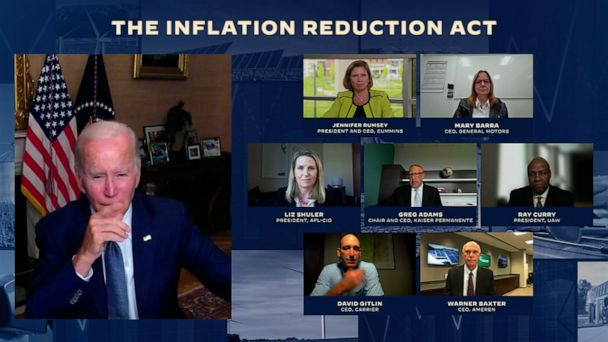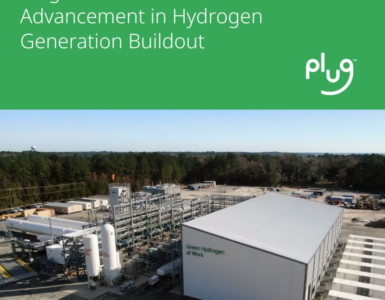Inflation Reduction Act: key green and blue hydrogen and CCUS provisions.
The U.S. Congress has passed, as of the Inflation Reduction Act (IRA or the “Act”), which is expected to be signed into law by President Joe Biden very soon.
The IRA is one of the biggest investments in clean energy in history and a major step towards reducing the United States’ greenhouse gas emissions.
According to the Biden Administration, the Act will result in the investment of $369 billion in energy and climate change programs and will avoid 6.3 billion tons of cumulative greenhouse gas emissions by 2030, amounting to a 40 percent annual emissions reduction compared to 2005 levels.
🔥 What about we co-host a webinar? Let's educate, captivate, and convert the hydrogen economy!
Hydrogen Central is the global go-to online magazine for the hydrogen economy, we can help you host impactful webinars that become a global reference on your topic and are an evergreen source of leads. Click here to request more details
For perspective, without the Act, the U.S. would only be able to reduce its GHG emissions by 26 percent by 2030 (again compared to 2005 levels).
This article focuses on the clean energy provisions of the IRA, in particular incentives and provisions pertaining to hydrogen and carbon capture, utilization and sequestration (CCUS). For a brief analysis of the Act’s other provisions, including the Corporate Book Minimum Tax, see our summary of the IRA.
The Focus is on the Reduction in Emissions, not the Technology Chosen by a Hydrogen Producer
The clean energy provisions of the Act support reduced carbon sources of energy regardless of the technologies used to achieve the carbon reductions: they are “source agnostic.”
This is welcome news for various industries within the U.S. that have been planning to invest in hydrogen and carbon sequestration technologies as well as conventional clean energy sources, including solar and wind.
In particular, the Act does not distinguish between hydrogen produced from electrolysis using renewable sources or nuclear power, nor does it distinguish between hydrogen produced by electrolysis or from natural gas with carbon capture and storage (so-called “blue” hydrogen).
Importantly for green hydrogen producers, however, it will be possible to combine tax credits for renewable power generation facilities alongside the PTCs and ITCs for clean hydrogen production and storage infrastructure.
The IRA extends existing investment tax credits (ITCs) and production tax credits (PTCs) for solar and wind power generation until 2024. After 2024, any carbon-free generation will have the option to either choose from an ITC or a PTC, whichever is more viable for each business, or choose to monetize the credits by transferring them to another unrelated third-party.
Game Changing Tax Credits and Direct Payments for “Qualified Clean Hydrogen”
The Act adds section 45V to the U.S. Internal Revenue Code of 1986 (the “Code”) to provide a tax credit for the production of “qualified clean hydrogen” produced by a taxpayer at a “qualified clean hydrogen production facility” during a 10-year period beginning on the date such facility was placed in service.
As described below, the base tax credit amount is set at $.60 per kilogram of clean hydrogen but increases to $3.00 per kilogram when the hydrogen’s lifecycle carbon intensity measures between zero and 0.45 kilograms of CO2 equivalent (CO2e) per kilogram of hydrogen (H2) and when the taxpayer complies with the prevailing wages and apprenticeship requirements.
Importantly, the Act includes a “direct pay option” for the same amounts instead of a tax credit. The direct payment for hydrogen and carbon capture facilities will be available for a limited period (the first five years of production) amount.
Alternatively, the IRA also includes an option for taxpayers to monetize the credits by transferring them to another taxpayer.
The potential to access a US$3 tax credit or direct payment for each kilogram of low-carbon hydrogen is truly revolutionary for the emerging green hydrogen industry. Some sources claim that it will make green hydrogen structurally cheaper than gray hydrogen and might reduce the cost of green hydrogen production to as low as $0.73 per kilograms in the U.S. Northwest.
On more conservative estimates it will likely halve the cost of production of green hydrogen in many places in the U.S. In either case it immediately makes green hydrogen a competitive source of energy compared to its fossil fuel alternatives.
In addition to the PTCs for clean hydrogen, the IRA creates a 30 percent credit for energy storage technology constructed before January 1, 2025. Whilst the text of the legislation is not precise on what sorts of infrastructure this might cover, it clearly does apply to hydrogen-related storage.
The bottom line is this: when combined with the ITCs for renewable power production and energy storage infrastructure, the entire upstream value chain for green hydrogen production infrastructure, from well (i.e., electron generation) to gate (i.e., the outlet of storage facilities), is now subsidized by the U.S. government.
This positions the U.S. as among the most competitive places in the world to develop green hydrogen projects across the value chain.
It will inevitably spur other countries to develop subsidies of their own to ensure domestic production, and the IRA should therefore be viewed as a significant boost to the development of a worldwide hydrogen economy.
Support for CCS Facilities Boost Blue Hydrogen Production
The Act amends Section 45Q of the Code to provide tax credits for the construction of carbon capture facilities. Any carbon capture, direct air capture or carbon utilization project that begins construction prior to January 1, 2033, will qualify for the Section 45Q tax credit.
Additionally, the Act not only extends carbon capture tax credits through 2033 but also lowers the requirements for additional carbon capture facilities to qualify.
The Act increases the Section 45Q base tax credit for carbon capture by industrial facilities and power plants to $85 per metric ton for CO2 stored in geologic formations, $60 per ton for the beneficial utilization of captured carbon emissions and $60 per ton for CO2 stored in oil and gas fields.
Energy Innovation and Green Industry also Supported
The IRA encourages technological developments in energy innovation. Under the Office of Clean Energy Demonstration (OCED), the IRA creates a $5.8 billion program, available through September 2026, to invest in projects aimed at reducing emissions from hard-to-abate energy intensive industries, such as iron, steel, cement and chemical production, and includes retrofit facilities.
The U.S. Congress has passed, as of today, the Inflation Reduction Act (IRA or the “Act”), which is expected to be signed into law by President Joe Biden very soon.
The IRA is one of the biggest investments in clean energy in history and a major step towards reducing the United States’ greenhouse gas emissions.
According to the Biden Administration, the Act will result in the investment of $369 billion in energy and climate change programs and will avoid 6.3 billion tons of cumulative greenhouse gas emissions by 2030, amounting to a 40 percent annual emissions reduction compared to 2005 levels.
For perspective, without the Act, the U.S. would only be able to reduce its GHG emissions by 26 percent by 2030 (again compared to 2005 levels).
This article focuses on the clean energy provisions of the IRA, in particular incentives and provisions pertaining to hydrogen and carbon capture, utilization and sequestration (CCUS). For a brief analysis of the Act’s other provisions, including the Corporate Book Minimum Tax, see our summary of the IRA.
The Focus is on the Reduction in Emissions, not the Technology Chosen by a Hydrogen Producer
The clean energy provisions of the Act support reduced carbon sources of energy regardless of the technologies used to achieve the carbon reductions: they are “source agnostic.”
This is welcome news for various industries within the U.S. that have been planning to invest in hydrogen and carbon sequestration technologies as well as conventional clean energy sources, including solar and wind.
In particular, the Act does not distinguish between hydrogen produced from electrolysis using renewable sources or nuclear power, nor does it distinguish between hydrogen produced by electrolysis or from natural gas with carbon capture and storage (so-called “blue” hydrogen).
Importantly for green hydrogen producers, however, it will be possible to combine tax credits for renewable power generation facilities alongside the PTCs and ITCs for clean hydrogen production and storage infrastructure.
The IRA extends existing investment tax credits (ITCs) and production tax credits (PTCs) for solar and wind power generation until 2024. After 2024, any carbon-free generation will have the option to either choose from an ITC or a PTC, whichever is more viable for each business, or choose to monetize the credits by transferring them to another unrelated third-party.
Game Changing Tax Credits and Direct Payments for “Qualified Clean Hydrogen”
The Act adds section 45V to the U.S. Internal Revenue Code of 1986 (the “Code”) to provide a tax credit for the production of “qualified clean hydrogen” produced by a taxpayer at a “qualified clean hydrogen production facility” during a 10-year period beginning on the date such facility was placed in service.
As described below, the base tax credit amount is set at $.60 per kilogram of clean hydrogen but increases to $3.00 per kilogram when the hydrogen’s lifecycle carbon intensity measures between zero and 0.45 kilograms of CO2 equivalent (CO2e) per kilogram of hydrogen (H2) and when the taxpayer complies with the prevailing wages and apprenticeship requirements.
Importantly, the Act includes a “direct pay option” for the same amounts instead of a tax credit. The direct payment for hydrogen and carbon capture facilities will be available for a limited period (the first five years of production) amount.
Alternatively, the IRA also includes an option for taxpayers to monetize the credits by transferring them to another taxpayer.
The potential to access a US$3 tax credit or direct payment for each kilogram of low-carbon hydrogen is truly revolutionary for the emerging green hydrogen industry. Some sources claim that it will make green hydrogen structurally cheaper than gray hydrogen and might reduce the cost of green hydrogen production to as low as $0.73 per kilograms in the U.S. Northwest.
On more conservative estimates it will likely halve the cost of production of green hydrogen in many places in the U.S. In either case it immediately makes green hydrogen a competitive source of energy compared to its fossil fuel alternatives.
In addition to the PTCs for clean hydrogen, the IRA creates a 30 percent credit for energy storage technology constructed before January 1, 2025. Whilst the text of the legislation is not precise on what sorts of infrastructure this might cover, it clearly does apply to hydrogen-related storage.
The bottom line is this: when combined with the ITCs for renewable power production and energy storage infrastructure, the entire upstream value chain for green hydrogen production infrastructure, from well (i.e., electron generation) to gate (i.e., the outlet of storage facilities), is now subsidized by the U.S. government.
This positions the U.S. as among the most competitive places in the world to develop green hydrogen projects across the value chain. It will inevitably spur other countries to develop subsidies of their own to ensure domestic production, and the IRA should therefore be viewed as a significant boost to the development of a worldwide hydrogen economy.
Support for CCS Facilities Boost Blue Hydrogen Production
The Act amends Section 45Q of the Code to provide tax credits for the construction of carbon capture facilities. Any carbon capture, direct air capture or carbon utilization project that begins construction prior to January 1, 2033, will qualify for the Section 45Q tax credit.
Additionally, the Act not only extends carbon capture tax credits through 2033 but also lowers the requirements for additional carbon capture facilities to qualify.
The Act increases the Section 45Q base tax credit for carbon capture by industrial facilities and power plants to $85 per metric ton for CO2 stored in geologic formations, $60 per ton for the beneficial utilization of captured carbon emissions and $60 per ton for CO2 stored in oil and gas fields.
Energy Innovation and Green Industry also Supported
The IRA encourages technological developments in energy innovation. Under the Office of Clean Energy Demonstration (OCED), the IRA creates a $5.8 billion program, available through September 2026, to invest in projects aimed at reducing emissions from hard-to-abate energy intensive industries, such as iron, steel, cement and chemical production, and includes retrofit facilities.
Inflation Reduction Act: Key Green and Blue Hydrogen and CCUS Provisions, August 15, 2022









1 comment